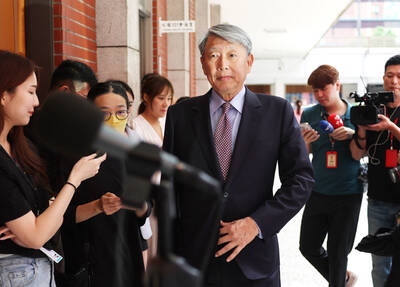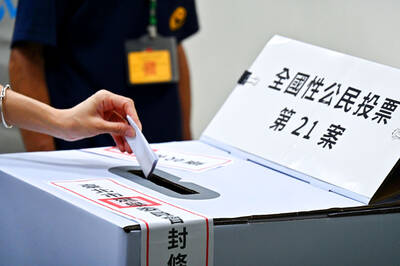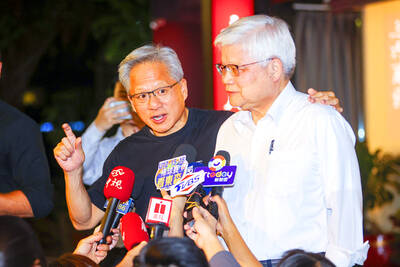The audio-visual market in Asia, which accounts for 30 percent of global revenues, should further expand and overtake Europe in the next 10 to 12 years, industry experts said yesterday.
Demand for projectors, plasma television screens and ultra-thin video displays is expected to increase, according to organizers of Asia's top industry conference and exhibition, InfoComm Asia, to be held in Singapore next month.
The audio-visual equipment can be used for a wide array of purposes, from company data presentation and video conferencing, to military command and control facilities and churches and schools.
A growing market in the entertainment industry and demand for home theatre systems should also help power the expansion, they said.
"Infocommunications [information and communications] has grown as an industry, in terms of the revenues it generates," said Nat Wong, managing director of InfoCommAsia, which is organizing the exhibition.
For example, revenue from large screen displays for big venues and public viewing is expected to increase to US$7 billion in 2008 from US$3 billion in 2001, Wong told a news briefing here.
Plasma display panel sales are seen rising to 12 million units by 2005 from 4.7 million units in 2001, while home projector sales are expected to soar to 5.9 million units in 2005 from just 98,000.
Sales of data projectors, used for audio-visual presentations, are forecast to surge more than 200 percent to 510,000 by the end of next year from 159,000 in 2000.
No overall sales or revenue figures are currently available for the industry.
But data from industry manu-facturers show Asia currently accounts for 30 percent of the global market for audio-visual equipment.
This could further increase and overtake Europe's 35 percent share in the next 10 to 12 years, Wong said.
"The demand, the population and the growth potential is here. I can only see Asia growing because the opportunities are great," he said.
Randal Lemke, executive director of the US-based International Industries Association, which is sponsoring the exhibition, said requirements by the world's top companies for video conferencing and presentations should drive global growth.
But for Asia, Wong said a growing market is in the education sector, which is increasingly using projectors, large screens and sound systems in the teaching and learning process.
Singapore is a key market because of its bid to become a regional hub for education by 2012.
The government is to build 40 private commercial and specialty schools, while the Singapore Management University will construct 12 more buildings by 2005 all equipped with state-of-the art audio-visual equipment.
Malaysia is also building top notch audio-visual facilities for its convention and exhibition center, as well as hotels.
Thailand expects to make its cinemas fully digitalized and is building a modern opera house which will require top-level projection systems.
Hong Kong's Disneyland project and China's hosting of the 2008 Olympics should fuel demand for audio-visual technology.
India is a potential market for cable, video, DVD and home theater systems because of its burgeoning entertainment industry.
Next month's InfoCommAsia conference and exhibition is expected to shift the focus from products to integrated systems solutions.
Among the displays will be wireless network and large format projectors, inflatable outdoor screens and ultra-thin video cubes.

CHIPMAKING INVESTMENT: J.W. Kuo told legislators that Department of Investment Review approval would be needed were Washington to seek a TSMC board seat Minister of Economic Affairs J.W. Kuo (郭智輝) yesterday said he received information about a possible US government investment in Taiwan Semiconductor Manufacturing Co (TSMC, 台積電) and an assessment of the possible effect on the firm requires further discussion. If the US were to invest in TSMC, the plan would need to be reviewed by the Department of Investment Review, Kuo told reporters ahead of a hearing of the legislature’s Economics Committee. Kuo’s remarks came after US Secretary of Commerce Howard Lutnick on Tuesday said that the US government is looking into the federal government taking equity stakes in computer chip manufacturers that

Chinese Nationalist Party (KMT) lawmakers have declared they survived recall votes to remove them from office today, although official results are still pending as the vote counting continues. Although final tallies from the Central Election Commission (CEC) are still pending, preliminary results indicate that the recall campaigns against all seven KMT lawmakers have fallen short. As of 6:10 pm, Taichung Legislators Yen Kuan-heng (顏寬恒) and Yang Chiung-ying (楊瓊瓔), Hsinchu County Legislator Lin Szu-ming (林思銘), Nantou County Legislator Ma Wen-chun (馬文君) and New Taipei City Legislator Lo Ming-tsai (羅明才) had all announced they

POWER PLANT POLL: The TPP said the number of ‘yes’ votes showed that the energy policy should be corrected, and the KMT said the result was a win for the people’s voice The government does not rule out advanced nuclear energy generation if it meets the government’s three prerequisites, President William Lai (賴清德) said last night after the number of votes in favor of restarting a nuclear power plant outnumbered the “no” votes in a referendum yesterday. The referendum failed to pass, despite getting more “yes” votes, as the Referendum Act (公民投票法) states that the vote would only pass if the votes in favor account for more than one-fourth of the total number of eligible voters and outnumber the opposing votes. Yesterday’s referendum question was: “Do you agree that the Ma-anshan Nuclear Power Plant

Nvidia Corp CEO Jensen Huang (黃仁勳) yesterday visited Taiwan Semiconductor Manufacturing Co (TSMC, 台積電), as the chipmaker prepares for volume production of Nvidia’s next-generation artificial intelligence (AI) chips. It was Huang’s third trip to Taiwan this year, indicating that Nvidia’s supply chain is deeply connected to Taiwan. Its partners also include packager Siliconware Precision Industries Co (矽品精密) and server makers Hon Hai Precision Industry Co (鴻海精密) and Quanta Computer Inc (廣達). “My main purpose is to visit TSMC,” Huang said yesterday. “As you know, we have next-generation architecture called Rubin. Rubin is very advanced. We have now taped out six brand new